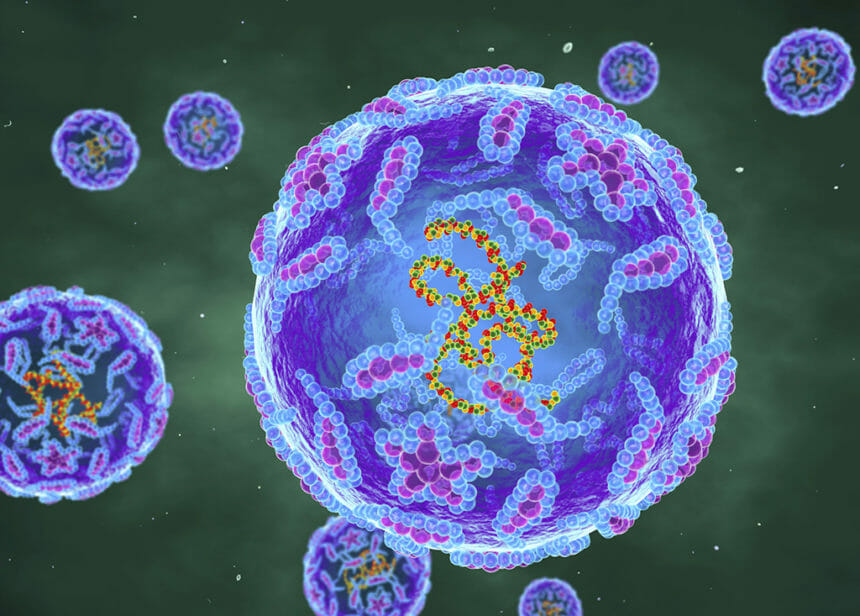Amid the COVID-19 pandemic and ongoing monkeypox surge, the United States has apparently welcomed back polio, a disease that was all but eradicated in 1979 due to widespread vaccination.
Last month, New York State reported the country’s first case of polio since 2013 — which itself was only the second case of polio in 43 years. In the weeks that followed, health officials sounded the alarm on further spread after the virus was detected in New York City wastewater samples.
Polio’s reemergence underlines a pair of recurring themes from the last two years: The need to boost vaccination rates to prevent outbreaks of infectious disease, and the need to craft effective messaging in a climate of increasing vaccine hesitancy.
It should be noted that it isn’t unheard of for polio to pop up in places that have eliminated it. Given the virus’ continued existence in other countries, there’s always the possibility for travelers to bring it to the U.S. But the likelihood of outbreaks increases if there are swaths of the country with low vaccination rates, according to Anna Bershteyn, assistant professor of population health at NYU Grossman School of Medicine.
“If you have a pocket with low vaccination rates, there’s a risk of polio reappearing,” Bershteyn said. “It’s a big problem to deal with, but it doesn’t need to be a problem. We just need to make sure people have information, encouragement and the fewest barriers possible for vaccination.”
The individual infected with the virus, who lives in New York’s Rockland County, was unvaccinated. The patient developed paralysis, a severe outcome that affects less than 1% of infected people.
According to a newly released Centers for Disease Control and Prevention report, the individual hadn’t traveled anywhere internationally and the origin of the transmission is unknown. Iit likely came from a person who had received a type 2-containing oral polio vaccine (OPV) in another country. As a result, it’s likely the virus has been spreading for months in areas including New York City.
People who receive OPV can still transmit the virus to unvaccinated people. The U.S. stopped administering OPV in 2000 and now uses the inactivated polio vaccine (IPV).
“Low vaccination coverage in the patient’s country of residence indicates that the community is at risk for additional cases of paralytic polio,” the authors of the CDC report wrote. “Even a single case of paralytic polio represents a public health emergency in the United States.”
Rockland and Orange Counties both have particularly low polio vaccination rates, at about 60% and 58%, respectively. The national polio vaccination rate is around 93%.
In Rockland, the polio vaccination rate fell significantly during the pandemic, from 67% in July 2020 to 60% in August 2022. That was in line with an overall drop in routine immunizations during the same period. In some zip codes in Rockland County, the polio vaccination rate has sunk as low as 37%.
Amid the polio resurgence, CDC director Dr. Rochelle Walensky has called for an overhaul of the agency in the wake of its COVID-19 missteps. Taken together, the systemic failures reinforce the need for a public health system that’s better prepared to handle infectious disease outbreaks.
As its focus has shifted from COVID-19 to monkeypox to polio, the country has taken few steps to address the underlying issues in its public health infrastructure and vaccination efforts.
“The way off the treadmill is to stop jumping from disaster to disaster, and think about this in a more holistic way,” Bershteyn said. “It could be measles next time. We shouldn’t just laser-focus on polio or monkeypox or different pandemic viruses when they happen, because a lot of the things you need to do to prepare for those situations are common, no matter what the virus is.”
In its recent polio report, the CDC noted it will work to boost awareness among healthcare providers, test wastewater in New York counties and distribute IPV to providers.
Walter Orenstein, a physician and professor of medicine, epidemiology, global health and pediatrics at Emory University — and the former director of the U.S. National Immunization Program, which is now the National Center for Immunization and Respiratory Diseases — stressed the importance of enhanced wastewater surveillance.
“It’s not easy to do wastewater testing, so we need to make it easier and have staff both at the CDC and state level do more of it. We could be looking for polio as well as other infectious pathogens,” Orenstein said.
The biggest focus, however, will be addressing vaccine hesitancy.
“In a world where not many people remember what polio looks like – people in crutches or in iron lungs — they may think, ‘Why would I need this? This isn’t a problem for me,’” Bershteyn explained. “It’s important to keep investing in communities to encourage trust and understanding in vaccines and remove barriers to vaccination. such as making sure patients don’t need insurance or pay out-of-pocket to get a vaccine.”
And continually investing in the global polio eradication effort, such as by boosting the availability of IPV, will be crucial.
“People thought the eradication effort was working and that it’s not our problem in the U.S.,” Bernsteyn said. “This is a reminder that when it comes to infectious diseases, what’s going on internationally and global cooperation matter a lot for our health.”







